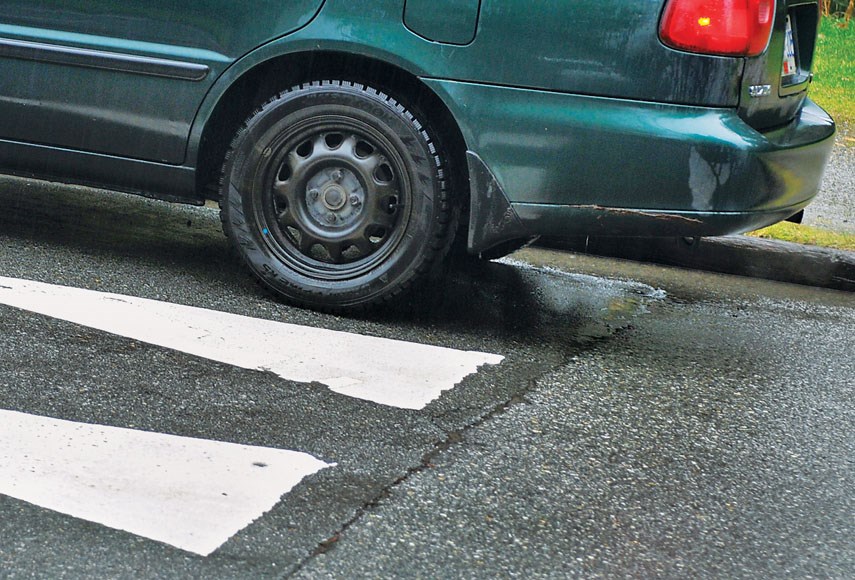The recent news that the District of West Vancouver council has unanimously voted to repeal a 30-year ban on speed bumps may be greeted with both amusement and satisfaction.
The amusement is generated by the fact that such a ban existed in the first place, which is an even more West Van thing than a Tesla accidentally backing into a G-Wagen at Park Royal.
The satisfaction comes with the knowledge that urban planners in the district once again have a simple tool in their arsenal to slow down routes where drivers seem to be getting carried away. Naturally, there’ll be a run on the market, with many neighbourhoods wanting their streets to start resembling a moguls course.
I’ll admit to occasionally finding speed bumps mildly annoying – unless we’re talking about my local streets, where I’d be perfectly happy to go one step further and install speed-sensing land mines. Thus, while turning onto a side street to see a chain of bumps might make me grumble a little, it does at least remind me to keep an eye on my speed. We all have days when we could use a little reminder.
Cracking open the history books, the speed bump appears to have been invented not long after the car itself. In 1906 Chatham, N.J., would-be speed-demons might find themselves thwarted by the newly installed crosswalk protections. From the March 7 issue of the New York Times from that year:
“Vehicles traveling at moderate pace will not be discomforted, but an automobile traveling at, say, forty miles an hour, which strikes one will rise several feet in the air and settle with a shock that will be anything but pleasant to the occupants.”
One can just imagine some straw-boater-hatted dandy smacking his Tin Lizzie off the speed bump at a high rate of speed and having the thing explode into a heap of smoking parts, like the bit at the end of The Blues Brothers. Highly satisfying stuff.
From these early vicious efforts, reportedly some five-inches high and made of slate, modern speed bumps evolved to be less of an outright barrier, and more of a traffic-controlling device. For the modern speed bump, we can thank no less than an actual Nobel Prize winning physicist.
Arthur Holly Compton is a pretty interesting guy. He won his Nobel for work on electromagnetism in 1927, appeared on the cover of Time magazine in 1936 – holding a cosmic ray detector – and was instrumental in the Manhattan Project, where he built reactors to convert uranium into plutonium, and helped create the atomic bomb.
With all that under his belt, whipping up a couple of speed bumps was basically a cinch. He began designing them in the 1950s, when he was annoyed at how fast motorists were passing the main hall at Washington University, where he was chancellor. Perhaps those motorists are lucky he didn’t shoot them with a death ray.
Compton called his inventions “traffic control bumps,” and put one into place in 1953. A simple idea, it took a surprisingly long time to catch on. Apparently, Europe didn’t get its first official speed bump until 1970. One wonders what they were using before then. Baguettes, one supposes.
And then, one day in 1987, West Vancouver banned them. I wonder why? Although, if you imagine what West Van traffic looked like in 1987, perhaps it’s not such a mystery.
Speed bumps, as differentiated from the smoother speed humps and speed tables (both of which slow drivers down less), have got to be a giant pain if you’re in a fire engine or other emergency vehicle, hurrying to the scene. Further, they’d be hell on the suspension of a bus, and just imagine the noise with dozens of old 1970s and ’80s jalopies creaking and groaning over the bumps.
These days, we mostly use the humps and tables, with the latter especially popular on bus routes. They’re less inconvenient, more a nudge to watch your speed than an uppercut to the suspension of your vehicle.
And, if you think about what North Shore traffic looks like these days, it’s easy to make the argument that having a few more of them around would make things safer. Our vehicles are universally more powerful and higher-riding, while also quieter inside. It’s all too easy to let your speed creep beyond what’s safe
or prudent.
Not so fast, says the speed bump, an old-fashioned and simple solution for our modern driving lives.
Brendan McAleer is a freelance writer and automotive enthusiast. If you have a suggestion for a column, or would be interested in having your car club featured, please contact him at [email protected]. Follow Brendan on Twitter: @brendan_mcaleer.



